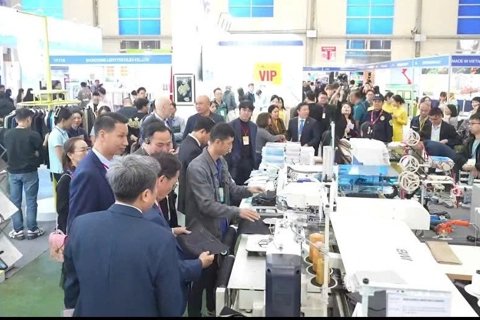Hanoi
To explore the skillful hand of Hanoians
Jul 28, 2017 / 11:07 AM
It’s essential to explore Hanoi’s craft villages when come to this thousand-year-old city
Bat trang pottery village
Bat Trang, traditional porcelain and pottery village with history of seven centuries, is an interesting attraction in Hanoi that tourists should not ignore. Bat Trang, the seven-century old pottery village, is an interesting attraction in Hanoi that tourists should not ignore.

Located in an area rich in clay, the village has advantage of ingredients to create fine ceramics. Visiting Bat Trang, tourists can take a walk or join a buffalo tour for sightseeing and shopping.

Besides many ceramic stores along the road in the village, tourists should visit Bat Trang Porcelain and Pottery Market where they can directly make pottery products by themselves. Many youngsters and foreign tourists are interested in in this pottery- making experience, and spend a whole day in the market to make a gift for family or friends.
Van Phuc silk village
Van Phuc Silk Village is situated on the banks of Nhue Thi River, Nguyen Trai Road, near Ha Dong city, 8 km southwest of Ha Noi. It takes you only 30 minutes by motorbike to go there from the centre of Hanoi.
Van Phuc silk village
Van Phuc Silk Village is situated on the banks of Nhue Thi River, Nguyen Trai Road, near Ha Dong city, 8 km southwest of Ha Noi. It takes you only 30 minutes by motorbike to go there from the centre of Hanoi.

The village has been much well known for its traditional sericulture, weaving, and silk products. Tourists coming here are lured by various beautiful shirts, crafts, ties, dresses and many other things made of silk available in the village. What is special is that the silk is made by very simple looms, which is the genuinely traditional Vietnamese way of making silk.

For centuries, silk has always been considered an extreme luxury, on par with rhinoceros horn, ivory and precious handworks in Vietnam. It has long been a universal byword of luxury, often worn by the richest, most powerful citizens. Today, the fine and lustrous cloth that originates from the cocoon of the silkworm is more affordable for "ordinary" folk. Furthermore, silk is currently enjoying a fashion renaissance, particularly since its many varieties can be made into a wide range of designs suitable for all facets of modern life. With 2000 years of history behind them, the silk weavers of Van Phuc Silk village are still busy, weaving dreams.
Chuong village
Chuong village is far about 30 kilometers from Hanoi, is located on Ha Dong road-Huong Tich pagoda. Chuong village belongs to Phuong Trung commune, Thanh Oai Distric, Hanoi. According to the seniors, the 'non' craft has had for a long time. Grandfather made 'non', father made 'non', son made 'non', grandchildren made 'non'.
Chuong village
Chuong village is far about 30 kilometers from Hanoi, is located on Ha Dong road-Huong Tich pagoda. Chuong village belongs to Phuong Trung commune, Thanh Oai Distric, Hanoi. According to the seniors, the 'non' craft has had for a long time. Grandfather made 'non', father made 'non', son made 'non', grandchildren made 'non'.

All members in family make 'non', the village has only single job is making 'non'. Because all people in the village make 'non', the market has most 'non' and things to make 'non'. Market has meeting in June, the main session on 4th, 10th, 14th, 24th and 30th lunar.

Today, despite people are not used these 'non' as often as it once was, the village market is still crowded and busy.Many Chuong villagers are good at making “non quai thao”, which is a special cultural feature of the Northern delta in Vietnam. The conical makers must be meticulous, skillful and have experience as the process is complicated, including choosing, arranging palm leaves, then sticking them on the conical ring, and sewing colorful thread. It sometimes takes the artisan a whole day to complete a nice “quai thao” conical hat.
Ha Thai Lecquerware Village
Traditional craft villages of Ha Thai lacquer lies the old highway 1A, near the Quan Ganh bridge, turn left on inter-communal Duyen Thai, pass viaduct then come to village.
Ha Thai Lecquerware Village
Traditional craft villages of Ha Thai lacquer lies the old highway 1A, near the Quan Ganh bridge, turn left on inter-communal Duyen Thai, pass viaduct then come to village.

Legend, Ha Thai paint job around the seventeenth century, then just paint job clarity. The land is not ancestral of Vietnam's paint job, but on Ha Thai painting ward was important because there are many talented craftsmen, skilled and creative.

Lacquer job have very elaborately, many stages. Each stage requires a professional to do it patiently, meticulously, take a loving care this job, if not, the complete product will not see a soul anywhere. It can be said lacquer technology only general principles, but differ in experience and techniques of each individual, each family, as it was making technical changes suitable paintings different create statue, different from decorative objects, paint cover golden age ... If you have a chance to Hanoi take a little time to visit Ha Thai trade village to get firsthand look at how the workers here blow soul in this art lacquer.
The village of Phu Vinh rattan and bamboo
Located 35 km from central Hanoi, the southwest, the village of Phu Vinh rattan and bamboo, Phu Nghia Chuong (Hanoi), is known as one of the famous traditional handicraft villages.

Lacquer job have very elaborately, many stages. Each stage requires a professional to do it patiently, meticulously, take a loving care this job, if not, the complete product will not see a soul anywhere. It can be said lacquer technology only general principles, but differ in experience and techniques of each individual, each family, as it was making technical changes suitable paintings different create statue, different from decorative objects, paint cover golden age ... If you have a chance to Hanoi take a little time to visit Ha Thai trade village to get firsthand look at how the workers here blow soul in this art lacquer.
The village of Phu Vinh rattan and bamboo
Located 35 km from central Hanoi, the southwest, the village of Phu Vinh rattan and bamboo, Phu Nghia Chuong (Hanoi), is known as one of the famous traditional handicraft villages.

In 2002, Phu Vinh village was officially recognized as the traditional village of rattan and bamboo, but Phu Vinh Phu Hoa old named page has been known for about 400 years.

Previously, bamboo and rattan products of the villagers are mostly baskets, mosquito, gradually, screening, bags, boxes ... appliances for daily life. But, life is growing, the needs of people on a high, fine art products such as rattan and bamboo ornaments, lampshades, curtains, portraits, landscape, horizontal, sentences as well as it was born.

Previously, bamboo and rattan products of the villagers are mostly baskets, mosquito, gradually, screening, bags, boxes ... appliances for daily life. But, life is growing, the needs of people on a high, fine art products such as rattan and bamboo ornaments, lampshades, curtains, portraits, landscape, horizontal, sentences as well as it was born.








